The Surrey Tapestry at Surrey History Centre is a 22.5 square metre epic work of art commissioned by Surrey County Council with major funding by the Arts Lottery Fund. The tapestry is in five panels, each depicting a different period in the County's history. Like their medieval counterparts, the weavers have created a visual image of history.
The design is by Philip Sanderson, and is multi-layered to convey a strong sense of the passage of time and the changes which accompany it.
A set of postcards featuring each of the five panels for £1 are available to purchase at Surrey History Centre or via our online shop (postage and packing are extra).
pre-Roman - Roman Panel
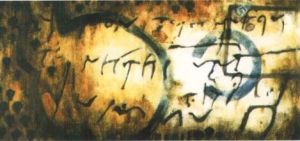 The design is based on aerial photography at Tadworth. The circular marks are the only remaining visible evidence of early settlements. Superimposed over them is Roman military text. The geometric forms emerge from the darkness.
The design is based on aerial photography at Tadworth. The circular marks are the only remaining visible evidence of early settlements. Superimposed over them is Roman military text. The geometric forms emerge from the darkness.
Weavers Jane Brunning and Barbara Winkler
Medieval Panel
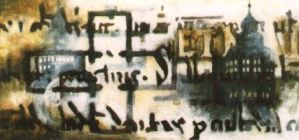 The granting of Magna Carta at Runnymede is a significant episode in English history. A section of the charter runs throughout the panel. The floor plan of Ewhurst Church lies on top of a Roman floor plan, creating a sense of development and change over time. The tower of Nonsuch Palace is accompanied by fragments of painted glass bearing the motto "Dieu et Mon Droit", which continues into the central panel.
The granting of Magna Carta at Runnymede is a significant episode in English history. A section of the charter runs throughout the panel. The floor plan of Ewhurst Church lies on top of a Roman floor plan, creating a sense of development and change over time. The tower of Nonsuch Palace is accompanied by fragments of painted glass bearing the motto "Dieu et Mon Droit", which continues into the central panel.
Weaver Caron Penney
The Surrey tapestry architectural panel
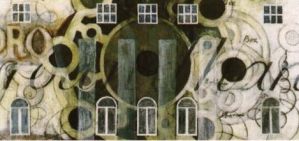 Here are references to famous houses and gardens of Surrey from the eighteenth and nineteenth centuries. The central garden motif is a Gertrude Jekyll design which has been combined with a window and column foundation from the south side of Clandon House. The word 'roundhand' runs through the centre of this panel, written in typically eighteenth century style.
Here are references to famous houses and gardens of Surrey from the eighteenth and nineteenth centuries. The central garden motif is a Gertrude Jekyll design which has been combined with a window and column foundation from the south side of Clandon House. The word 'roundhand' runs through the centre of this panel, written in typically eighteenth century style.
Weaver Phillip Sanderson
The Surrey tapestry nineteenth century - industrial age panel
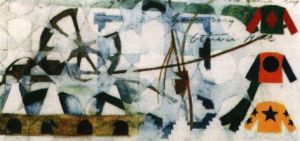 This panel reflects the importance of the railways - the Surrey Iron Railway being the first public line in Britain. There is also a reference to past industries of the county - the lime kilns at Brockham. Epsom racecourse can be seen in the background and is emphasised by the jockeys' silks on the right-hand edge. Woking had the first mosque in Britain and this is represented by the floor plan and Islamic decorative patterning which runs throughout the panel. The panel features part of a letter from Octavia Hill discussing the formation of the National Trust.
This panel reflects the importance of the railways - the Surrey Iron Railway being the first public line in Britain. There is also a reference to past industries of the county - the lime kilns at Brockham. Epsom racecourse can be seen in the background and is emphasised by the jockeys' silks on the right-hand edge. Woking had the first mosque in Britain and this is represented by the floor plan and Islamic decorative patterning which runs throughout the panel. The panel features part of a letter from Octavia Hill discussing the formation of the National Trust.
Weaver Louise Martin
The Surrey tapestry twentieth century panel
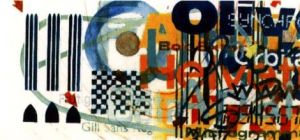 Here are windows of Guildford Cathedral, a plan of Brooklands racing circuit which was famous for motor racing (the chequered flag) and also used during the War (RAF roundel). A weather map of the great storm of 1987 runs through the panel becoming lost in the build up of the text/information representing the late twentieth century.
Here are windows of Guildford Cathedral, a plan of Brooklands racing circuit which was famous for motor racing (the chequered flag) and also used during the War (RAF roundel). A weather map of the great storm of 1987 runs through the panel becoming lost in the build up of the text/information representing the late twentieth century.
Weaver Jo Lord

